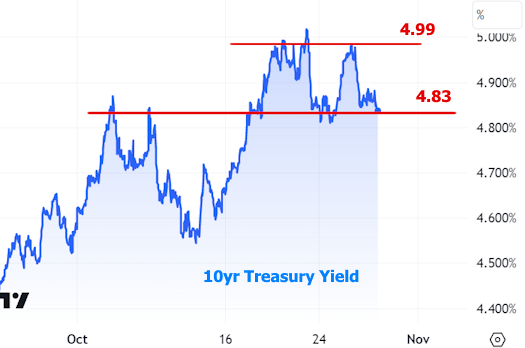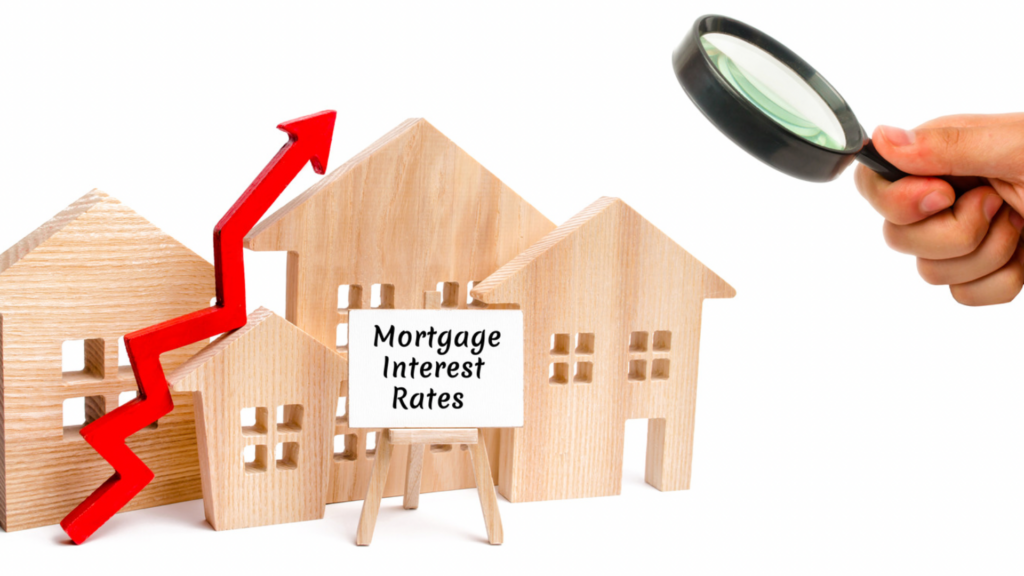In the week ahead, there is a lot at stake for mortgage rates. As we saw on Friday, there was minimal movement, but the long-term chart shows a steady rise. However, the Federal Reserve has hinted that it may not need to increase short-term rates anymore. Nonetheless, important economic data, such as the jobs report, will be released next week, and the Fed is expected to keep rates unchanged. If this data confirms economic softening, it could reinforce rate ceilings. On the other hand, strong data could push investors to explore 10-year yields in the 5% range. Should yields reach this level, it is possible that average top-tier mortgage rates could reach 8% or more. So, as the week unfolds, there is much to watch for and consider when it comes to rates.

Overview
On Friday, mortgage rates had minimal movement, with little change from the previous day. However, taking a long-term perspective, it is evident that rates have been steadily rising over time. This raises questions about the Federal Reserve’s stance on short-term rates and how upcoming important economic data may impact the mortgage market.
Mortgage Rates Movement on Friday
While Friday saw little movement in mortgage rates, it is important to consider the bigger picture. Recent trends suggest that rates have been on the rise, which could impact potential homebuyers and the real estate market as a whole. Analyzing long-term charts can provide valuable insights into the future trajectory of mortgage rates.
Long-Term Chart Analysis
When examining the long-term chart of mortgage rates, it becomes clear that there has been a steady rise over time. This indicates that mortgage rates may continue to increase in the foreseeable future, potentially reaching levels not seen in recent years. This could have significant implications for homeowners, homebuyers, and investors.
The Fed’s Stance on Short-Term Rates
The Federal Reserve, or the Fed, plays a crucial role in determining short-term interest rates. However, recent statements from the Fed indicate a potential shift in their stance. The central bank has suggested that it may not need to further hike short-term rates, signaling a possible pause in rate increases. This could have a ripple effect on mortgage rates and the overall housing market.
Upcoming Important Economic Data
Next week brings with it a slew of important economic data, including the jobs report. This data will shed light on the current state of the economy and potentially influence the Fed’s decision on interest rates. Investors and market participants eagerly await these indicators to gain insights into future market trends.
Expectations
As we look ahead, there are several expectations and potential scenarios that could impact mortgage rates and the housing market. Understanding these possibilities is crucial for homeowners, homebuyers, and investors alike.
The Fed’s Decision on Rates
The Fed’s decision on interest rates is highly anticipated by the market. Given the recent indications of a potential pause in rate hikes, it is expected that the central bank will keep rates unchanged in the near term. This can provide stability to the mortgage market and potentially impact borrowing costs.

Potential Impact of Economic Softening
If economic data confirms a softening of the economy, it could reinforce rate ceilings set by the Fed. This means that mortgage rates may remain within a certain range, providing some relief to borrowers. However, this could also signal a slowdown in the overall housing market and dampen demand for housing.
Potential Effect of Strong Data
On the other hand, strong economic data could push investors to explore higher yields, such as the 10-year yields in the 5% range. This could result in a rise in mortgage rates, making borrowing more expensive for homebuyers. While this may present opportunities for investors, it could hinder the affordability of mortgages for potential buyers.
Implications for Investors
Investors closely monitor mortgage rates and the housing market as they seek opportunities and manage risks. The different scenarios discussed above present various outcomes for investors to consider. Their sentiment and behavior will play a crucial role in shaping the market’s reaction to any changes in mortgage rates.
Possible Scenarios
To understand the potential impact on mortgage rates and the housing market, it is important to consider different scenarios that may unfold in the coming months.
Rates Remaining Unchanged
If the Fed maintains its current stance and keeps rates unchanged, it would provide stability to the market. Homebuyers can take advantage of relatively low rates, while investors can plan accordingly with a more predictable rate environment.
Rates Moving Higher
In the event that economic data strengthens and the Fed decides to resume rate hikes, mortgage rates could start moving higher. This would increase borrowing costs for homebuyers and potentially slow down the housing market. Investors, however, may find opportunities in higher yields.
Mortgage Rates Reaching 8%+
If yields reach higher levels, such as the 5% range in 10-year yields, it could push average top-tier mortgage rates to 8% or beyond. Such a significant increase in borrowing costs would have a profound impact on the affordability of mortgages and may significantly alter the dynamics of the housing market.

Investor Response to Different Scenarios
Investors need to carefully evaluate the potential effects of different scenarios on their portfolios. In a stable rate environment, they may continue to seek out attractive investment opportunities. However, in a rising rate environment, they may need to adjust their strategies to mitigate risks and capitalize on potential market shifts.
Factors Influencing Rates
Several factors influence mortgage rates, and understanding them can provide valuable insights into their movement. These factors range from economic indicators to global market influences.
Economic Indicators
Economic indicators, such as GDP growth, inflation, and consumer sentiment, play a significant role in determining mortgage rates. Positive economic data may lead to higher rates, as it signals a stronger economy and potentially higher inflation.
Inflation Expectations
Expectations regarding future inflation can greatly impact mortgage rates. If inflation is projected to rise, lenders may increase rates to offset the eroding value of the money they lend. Conversely, if inflation is expected to remain low, mortgage rates may be more favorable.
Employment Data
Job market trends are a crucial factor in mortgage rate determination. A healthy job market with low unemployment rates can lead to higher rates, as it suggests a stronger economy. On the other hand, a slowdown in job growth or rising unemployment can lead to lower rates.
Government Policies
Government policies, especially those related to fiscal and monetary measures, can influence mortgage rates. Changes in tax policies, housing regulations, or central bank actions can have a direct impact on borrowing costs.
Global Market Influences
Mortgage rates are also influenced by global market dynamics. Factors such as geopolitical events, global economic trends, and shifts in investor sentiment can sway rates. Market participants need to be aware of these influences to make informed decisions regarding mortgages and investments.

Rate Ceilings and Floors
In addition to considering the factors that influence rates, it is essential to understand rate ceilings and floors. These provide boundaries within which mortgage rates are likely to fluctuate.
Reinforcement of Rate Ceilings
If economic data confirms a softening of the economy, the Fed may reinforce rate ceilings. This means that mortgage rates may remain within a certain range, providing stability to borrowers. This can be advantageous for individuals looking to enter the housing market or refinance their existing mortgages.
Potential Floor for Rates
While rate ceilings are important to consider, it is also worth exploring potential rate floors. If economic conditions deteriorate or there is an unexpected shock to the economy, mortgage rates may reach historically low levels. This can present opportunities for potential homebuyers to secure favorable rates for their mortgages.
Fed’s Role
Understanding the Federal Reserve’s role in determining rates is crucial for navigating the mortgage market. The Fed’s decision-making process, impact on rates, and monitoring of economic indicators all influence the mortgage market.
The Fed’s Decision-Making Process
The Federal Reserve evaluates various economic indicators and market conditions to make decisions regarding short-term interest rates. Their goal is to promote price stability, maximum employment, and sustainable economic growth. These decisions have a direct impact on mortgage rates and the housing market.
Impact of the Fed’s Stance on Rates
The Fed’s stance on short-term rates influences borrowing costs for mortgages. If the Fed signals a pause in rate hikes or decides to cut rates, it can lead to lower mortgage rates. On the other hand, if they resume rate hikes, mortgage rates are likely to increase.
Monitoring Economic Indicators
The Federal Reserve closely monitors economic indicators to assess the health of the economy and make informed decisions regarding rates. This includes analyzing GDP growth, inflation trends, employment data, and consumer spending patterns. These indicators provide insights into the overall state of the economy and guide the Fed’s rate decisions.

Long-Term Consequences of Rate Decisions
The Fed’s rate decisions have long-term consequences for the housing market and the broader economy. Lower rates can stimulate borrowing and economic growth, while higher rates can curb inflation and prevent an overheated economy. Understanding the potential long-term effects of rate decisions is essential for homeowners, homebuyers, and investors.
Potential Impact on Housing Market
Mortgage rates have a direct impact on the housing market, affecting affordability, demand, and overall market outlook. Analyzing the potential impact of changing rates is crucial for individuals involved in the real estate industry.
Affordability of Mortgages
Rising mortgage rates can make homes less affordable for potential buyers. As rates increase, monthly mortgage payments also rise, potentially deterring buyers from entering the market. This can lead to a slowdown in demand and impact the overall health of the housing market.
Demand for Housing
Changes in mortgage rates can impact the demand for housing. Lower rates can incentivize potential buyers to enter the market, while higher rates can deter them. A slowdown in demand can lead to increased inventory and potentially lower home prices. Conversely, strong demand can drive up prices in a competitive market.
Effect on Homebuyers and Sellers
Mortgage rate movements affect both homebuyers and sellers. For homebuyers, higher rates mean increased borrowing costs and potentially decreased purchasing power. Sellers may face challenges in finding qualified buyers if rates become less favorable. The dynamics between buyers and sellers can shift as rates fluctuate.
Real Estate Market Outlook
The outlook for the real estate market heavily relies on mortgage rates. Market participants closely monitor rate movements to assess market conditions and make informed decisions. The potential impact of changing rates on supply, demand, and pricing dynamics will shape the future of the real estate market.
Investors’ Perspectives
Investors play a significant role in the mortgage market, seeking opportunities and managing risks. Understanding their perspectives and considerations is crucial for predicting market reactions.
Investor Sentiment and Behavior
Investors’ sentiment and behavior can greatly influence mortgage rates and the overall market. Positive investor sentiment can drive demand for mortgage-backed securities, which can lead to lower rates. Conversely, negative sentiment can drive investors away from the mortgage market, potentially pushing rates higher.
Exploring 10-Year Yields in the 5% Range
Strong economic data may push investors to explore higher yields, such as the 10-year yields in the 5% range. This presents an attractive alternative to mortgage-backed securities and may impact the availability and cost of mortgage financing.
Risks and Opportunities for Investors
Investors weigh various risks and opportunities in the mortgage market. Rising rates may lead to increased default risk, while declining rates can present opportunities for refinancing or investment in mortgage-related assets. Understanding these dynamics is essential for investors to optimize their portfolios.
Possible Market Reactions
The market’s reaction to changing mortgage rates can significantly impact the performance of mortgage-backed securities and other related assets. Investor behavior, market liquidity, and overall economic conditions all influence how the market responds to rate movements. Monitoring these reactions can provide insights into future market trends.
Long-Term Financial Planning
With mortgage rates playing a crucial role in financial planning, individuals and investors need to consider the long-term implications of changing rates.
Impact on Borrowing Costs
Higher mortgage rates directly impact borrowing costs, potentially affecting individuals’ budgets and financial plans. Planning for increased mortgage payments or seeking alternative financing options can help manage the impact of higher rates.
Strategies for Managing High Rates
Individuals and investors can implement strategies to manage high mortgage rates. Exploring different loan products, refinancing options, and budgeting for potential rate increases are all important considerations. Working with financial professionals can provide guidance on navigating a higher rate environment.
Considerations for Investments and Savings
Changing mortgage rates can also impact investment and savings plans. Higher rates may require adjusting investment strategies to potentially higher yields. Savers may explore higher-interest savings accounts or other avenues for maximizing returns while managing risks.
Conclusion
In conclusion, monitoring mortgage rate movements is essential for homeowners, homebuyers, investors, and anyone involved in the real estate market. Understanding the factors influencing rates, potential scenarios, and investors’ perspectives can provide valuable insights into the future trajectory of mortgage rates. Long-term financial planning should consider the implications of changing rates and adapt strategies accordingly. By staying informed and aware of rate movements, individuals can make informed decisions and navigate the dynamic mortgage market more effectively.
Source: https://www.mortgagenewsdaily.com/markets/mortgage-rates-10272023


